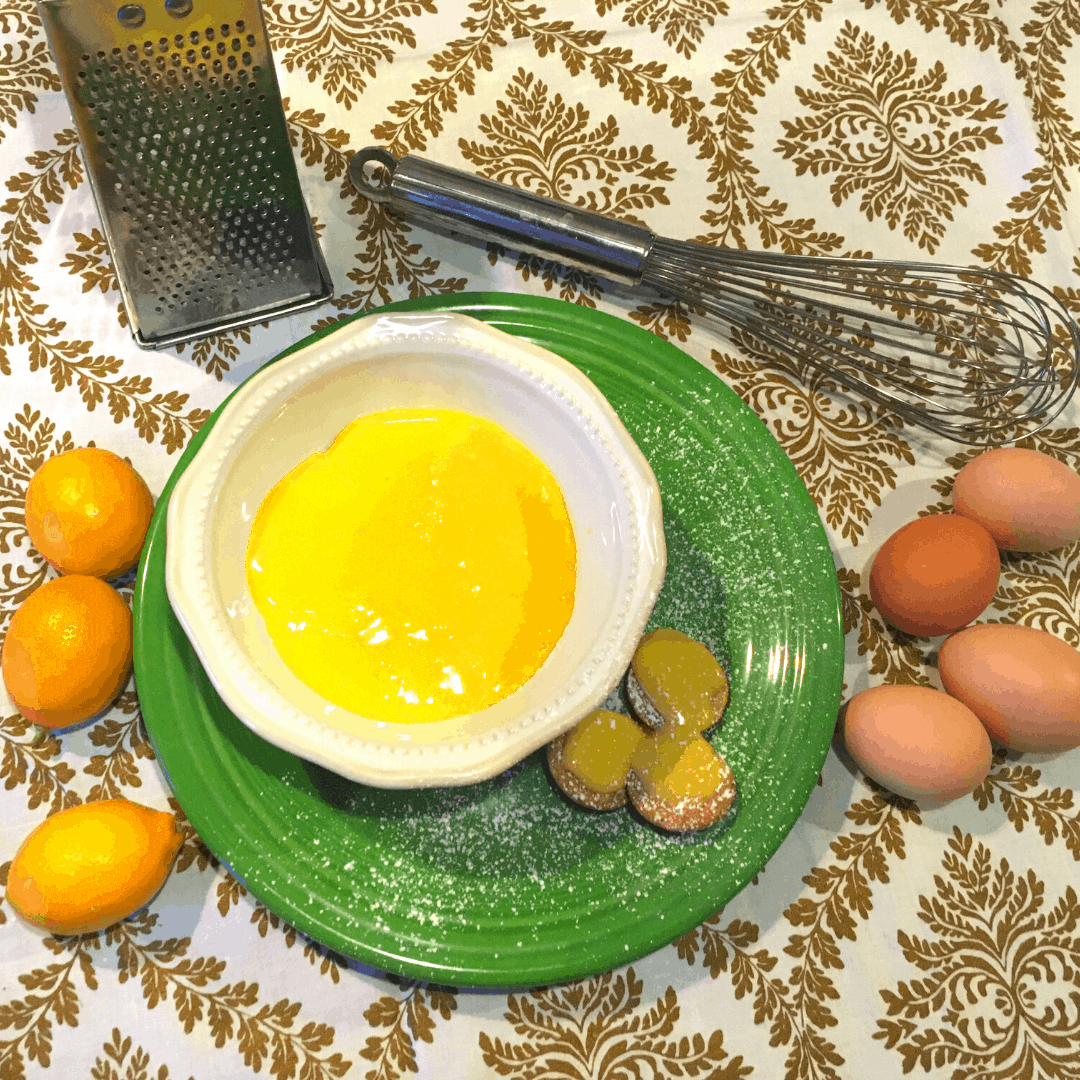Ahh, citrus season. There are so many cool things you can do to preserve and enjoy lemons, limes, oranges, and grapefruit! In this post though, I’m primarily going to focus on the delicious (though somewhat fussy to make) lemon curd!
Let’s just get right to it, shall we?
But First, a Bath
The first ingredient you will need is baking soda. This doesn’t actually go INTO the lemon curd, but I always give produce that isn’t from our garden a baking soda bath. Some people use vinegar baths while others use produce washes. I prefer a baking soda bath, as it’s been proven to remove pesticides.
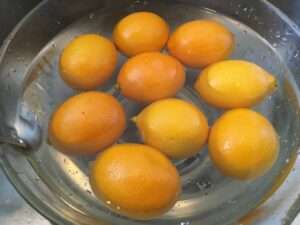
I put a healthy sprinkle of baking soda into a bowl of water and let it dissolve, and then let the produce (in this case Meyer lemons) soak for 30 minutes or so. If you need a more specific measurement than “a healthy sprinkle in a bowl,” Cook’s Illustrated says 2 teaspoons of baking soda per quart of water.
After the baking soda bath, make sure you rinse thoroughly – especially for lemon curd since you will be using the zest.
Lemon Curd Ingredients
There are actually only four ingredients in lemon curd.
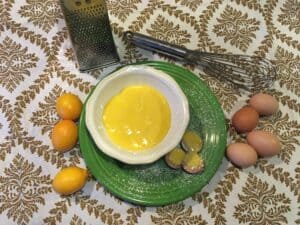
To make this recipe, which yields about 1 pint of lemon curd, you will need 3-4 lemons (I prefer Meyer lemons but regular lemons work too!)
You will also need the yolks from six eggs, 3/4 cup sugar, and one stick of unsalted butter.
(Now, keep in mind that almost everything I do features less sugar than “normal” – so if you want to increase the sugar to 1 cup you can.)
Making Lemon Curd
So, the recipe card is below if you want to jump down to it … but here’s the process in a bit more detail with some photos!
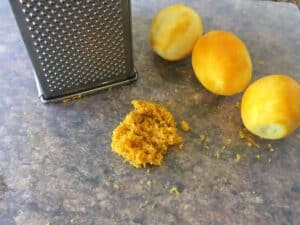
First, you take your 3-4 lemons and zest them. I made two batches this week – one with very cold lemons and one with room temperature lemons. They zested much better when the lemons were cold.
When I zested the room temperature lemons, the zest got kind of gummy in the grater. For this process, you can use either a lemon zester or a box grater with a zesting side.
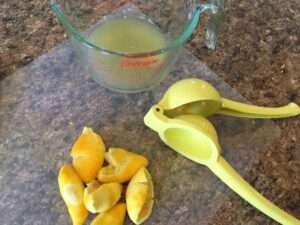
Next, slice your lemons in half and extract the juice. I use a manual press citrus juicer and it works well for me! I put my zest and lemon juice in a liquid measuring cup because you need about 1/2 cup of juice for this recipe.
(My husband asked if you could just make lemon curd with bottled lemon juice. You could, but you would be missing the extra lemon flavor from the zest. I’m pretty sure it would still be delicious though, if you wanted to skip this whole zesting and juicing process.)
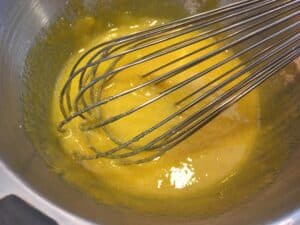
The next part is what I call the fussy part. I like to use a double boiler insert in my saucepan because it makes it a bit more foolproof than using just a saucepan by itself. So, turn your burner on medium to start and you may need to turn it down as you go.
Separate the yolks of six eggs (use an egg separator if you wish) and put them in the double boiler insert with 3/4 cup sugar (or up to 1 cup if you want your curd to be sweeter than mine.) Whisk the egg yolks and sugar together with a metal whisk for a minute until the sugar dissolves.
Sidenote: make sure you reserve those egg whites! You can make a tasty treat for the dogs or save them for tomorrow’s breakfast! Most recently, we made a plain white cake mix topped with my husband’s grandmother’s traditional beat and eat frosting. Between the cake mix and the frosting, we used most of the egg whites we had reserved from the lemon curd recipe!
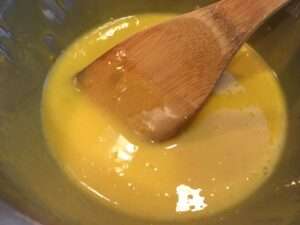
Next, trade your whisk for a wooden spoon and add your lemon juice and zest. Make sure your burner isn’t too hot – we aren’t making scrambled eggs like I *almost* did in my second batch. Continually stir the mixture on medium to medium-low heat for 15 minutes or so.
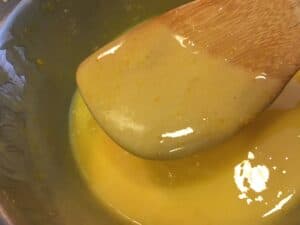
Depending on your heat level, it may be faster or it may take longer. It will have a relatively thick pudding-like consistency and the color changes a bit to a pretty golden yellow when it’s done.
(If you just use a regular saucepan instead of the double-boiler, it’s even more important to keep that burner temperature low and keep stirring. I’ve never made it without a double-boiler though and that’s what I recommend!)

While you are continually stirring that lemon curd, you can also take your stick of unsalted butter and cut it into slices. When you decide your curd is done, turn the burner off and stir the butter in until it melts.
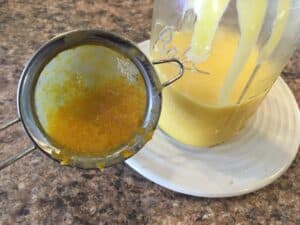
At this point, you can run your finished lemon curd through a fine-mesh strainer to get any of the lemon zest and potential egg bits out. Sometimes I’m patient enough for this, sometimes I’m not. The lemon curd tastes great either way!
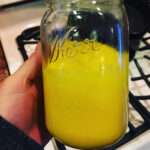
I like to store it in a mason jar in the refrigerator and eat it within a few weeks. Any other airtight container of your choice will work, and it also freezes well!
(Recipe and process adapted from Food in Jars.)
Enjoying Lemon Curd
So, how do you eat this lemon curd? It was delicious with the white cake I mentioned above, but we have enjoyed it a variety of other ways too (or you can just eat it on toast, or with a spoon!)

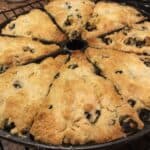
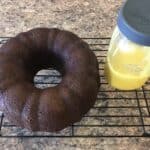

Other Ways to Preserve Citrus Fruit
If you are looking for some more ways to preserve citrus fruit, here are some of my other favorites:
Also, check out this recent video I shared about all the ways I like to preserve citrus fruit!
Like this post? Leave me a comment below! Also, don’t forget to check out MORE Food Preservation blog posts while you are here.
Lemon Curd
Equipment
- Mixing bowl
- Stovetop burner
- Double boiler insert with a saucepan
- Lemon zester or box grater
- Cutting board and knife
- Lemon juicer
- Liquid and dry measuring cups
- Egg separator (optional)
- Metal whisk
- Wooden spoon
- Fine mesh strainer
- Pint mason jar
Ingredients
Washing the Lemons
- 2 tsp Baking Soda
- 1 quart Water
The Lemon Curd
- 3-4 Meyer (or other) lemons
- 6 eggs, separated
- 3/4 cup sugar (up to 1 cup if you want it sweeter)
- 1 stick unsalted butter, sliced
Instructions
Washing the Lemons
- Dissolve the baking soda in a bowl of water and let the lemons soak for 20-30 minutes. This has been proven to remove any potential pesticides that may be on the fruit, which is important since you will be using the zest in this recipe.
Making the Lemon Curd
- Zest your lemons with a zester or box grater. This works best with cold lemons (versus room temperature.)
- Slice the lemons in half and juice them with a citrus juicer. Combine the zest and juice in a liquid measuring cup to equal 1/2 cup of juice. If you don't have enough, you can juice more lemons or add bottled lemon juice.
- Separate six eggs - for this recipe, we will only use the yolks. Reserve the whites for another use.
- Prepare a double boiler insert on the stove on heat to medium. Put the egg yolks in the double boiler insert with 3/4 cup sugar, and whisk for a minute to combine and dissolve sugar.
- Next, add the lemon juice and zest and switch to a wooden spoon. Keep an eye on your burner heat, you may need to turn it down as you go. Continually stir for 15 minutes or so (it may take less or more time, depending on your heat level.)
- Meanwhile, cut your stick of unsalted butter into slices and set aside.
- As you stir, it will start to thicken. You will know it is done when it is thick enough to stick to the back of the wooden spoon. At this point, it will also have a pudding-like consistency and a golden yellow color. When you determine it's done, turn off the heat and stir in your sliced stick of butter until it melts.
- At this point, you can run the finished curd through a fine-mesh strainer to filter out any lemon zest or potential cooked egg bits. Sometimes I do this process, sometimes I don't!
- Store in an airtight container in the refrigerator for up to a few weeks, or it freezes well.
- Enjoy your lemon curd with your favorite dessert or breakfast!

